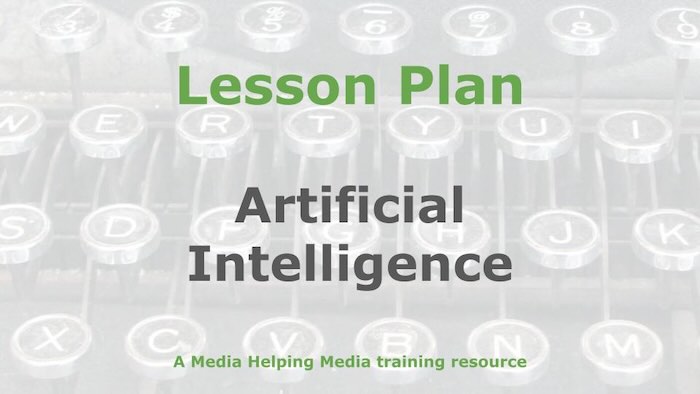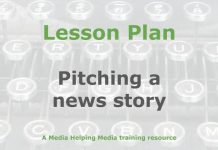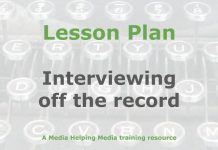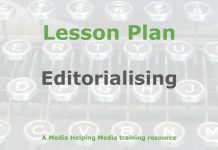 This one-day lesson outline is designed for working journalists and editors who want to understand how artificial intelligence (AI) is reshaping journalism.
This one-day lesson outline is designed for working journalists and editors who want to understand how artificial intelligence (AI) is reshaping journalism.
It’s based on five articles published on Media Helping Media which we recommend trainers study before adapting the following lesson outline for local needs. The lesson explores practical uses of AI, ethical issues, and verification strategies related to AI-assisted reporting and content creation.
Lesson running order
- 09:30 – 10:00 | Welcome and introduction
- Course objectives and schedule
- Participants’ expectations and prior experience with AI
- Brief overview of AI tools in journalism today
- 10:00 – 10:45 | Session 1: Hey AI, what’s on the news agenda today?
- Focus: Using AI to support editorial planning
- Summary: This article demonstrates how tools such as Google’s Gemini, ChatGPT and Perplexity can generate a list of trending topics and offer treatment suggestions, helping journalists structure their news agenda with fresh perspectives.
- Discussion: Benefits and limitations of generative AI in setting the news agenda.
- Exercise:
- Use a generative AI tool to generate a news list for today.
- Compare with the homepage of a leading news site.
- Reflect on what was missed or added? Is there a clear news hierarchy?
- 10:45 – 11:30 | Session 2: AI-assisted reporting
- Focus: Enhancing story development with AI
- Summary: This article explores how AI can serve as a partner in brainstorming, particularly for solo or under-resourced journalists. The aim is to show how AI can identify gaps in coverage and suggest fresh story angles.
- Exercise:
- Provide a story prompt to an AI tool.
- Ask for: follow-up angles, sources to approach, and suggested headlines.
- Share and discuss results in small groups.
11:30 – 11:45 | Break
- 11:45 – 12:30 | Session 3: Artificial intelligence assesses its role in journalism
- Focus: Opportunities and risks of AI tools
- Summary: This article, written by AI, evaluates its own potential in journalism. It highlights speed and scalability, but warns of risks including bias, lack of transparency, and misinformation.
- Exercise:
- Working in pairs, list three strengths and three weaknesses of AI in journalism.
- Group brainstorm: What editorial checks should exist when using AI outputs?
12:30 – 13:30 | Lunch break
- 13:30 – 14:15 | Session 4: How to detect AI-generated images
- Focus: Verifying visuals in the age of AI
- Summary: Based on real case studies, this article offers a step-by-step guide to spotting AI-generated visuals, such as those circulated after the Nepal earthquake.
- Tools introduced: Reverse image search, EXIF data checkers, watermark detectors
- Exercise:
- Review 5 images (some AI-generated, some real).
- Use tools and article guidance to verify authenticity.
- Discuss implications of falsely using AI images in journalism.
- 14:15 – 15:15 | Session 5: AI and investigative journalism
- Focus: Pattern detection and data analysis with AI
- Summary: This piece explains how AI can mine large volumes of documents or datasets to identify potential story leads. It shows promise in automating parts of the investigative process.
- Exercise:
- Review a sample dataset (e.g. government spending).
- Use an AI tool to ask questions about irregularities or trends.
- Discuss how these findings might shape an investigation.
15:15 – 15:30 | Afternoon break
- 15:30 – 16:30 | Session 6: Ethics workshop – balancing automation and editorial vversight
- Sources referenced:
- Focus: Ethical frameworks for AI use in journalism
- Discussion topics:
- Accountability: Who is responsible for errors from AI-generated content?
- Bias: How do we identify and mitigate algorithmic bias?
- Transparency: How should we disclose AI involvement to audiences?
- Exercise:
- Draft a newsroom guideline: “Our policy on AI use”
- Include transparency, verification, human oversight, and corrections protocols
- Share with the group and compare key principles
- 16:30 – 17:00 | Wrap-up and reflections
- Key takeaways from each session
- Group reflections: Where do we go from here?
- Feedback and certificates of participation
- Suggested further reading and AI tools to explore








